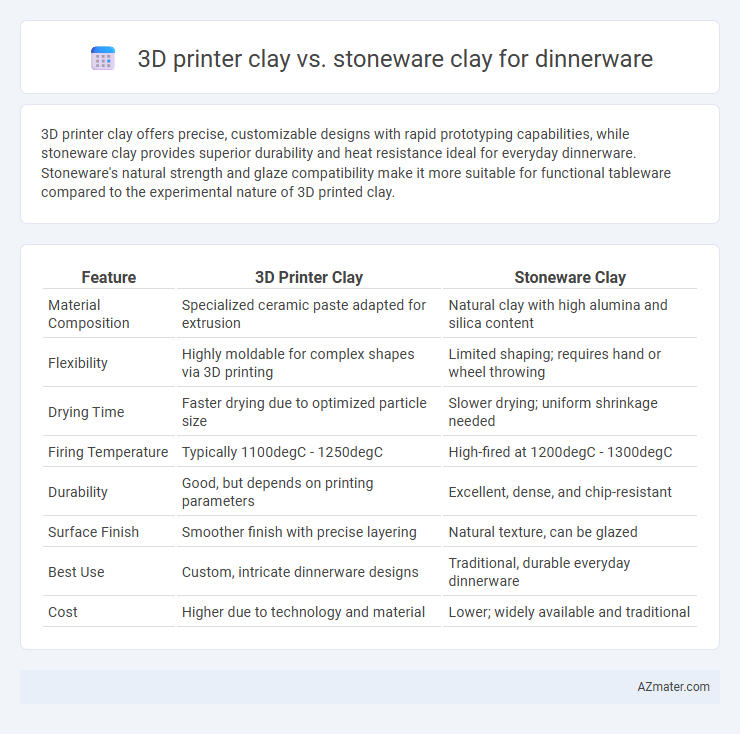3D printer clay offers precise, customizable designs with rapid prototyping capabilities, while stoneware clay provides superior durability and heat resistance ideal for everyday dinnerware. Stoneware's natural strength and glaze compatibility make it more suitable for functional tableware compared to the experimental nature of 3D printed clay.
Table of Comparison
| Feature | 3D Printer Clay | Stoneware Clay |
|---|---|---|
| Material Composition | Specialized ceramic paste adapted for extrusion | Natural clay with high alumina and silica content |
| Flexibility | Highly moldable for complex shapes via 3D printing | Limited shaping; requires hand or wheel throwing |
| Drying Time | Faster drying due to optimized particle size | Slower drying; uniform shrinkage needed |
| Firing Temperature | Typically 1100degC - 1250degC | High-fired at 1200degC - 1300degC |
| Durability | Good, but depends on printing parameters | Excellent, dense, and chip-resistant |
| Surface Finish | Smoother finish with precise layering | Natural texture, can be glazed |
| Best Use | Custom, intricate dinnerware designs | Traditional, durable everyday dinnerware |
| Cost | Higher due to technology and material | Lower; widely available and traditional |
Introduction: 3D Printer Clay vs. Stoneware Clay for Dinnerware
3D printer clay offers precise shaping capabilities and rapid prototyping, making it ideal for customized dinnerware designs with intricate details. Stoneware clay provides durability, heat resistance, and a traditional handcrafted feel, ensuring functional and long-lasting dinnerware pieces. Choosing between 3D printer clay and stoneware clay depends on the desired balance of design flexibility versus material strength and finish quality.
Material Composition and Properties
3D printer clay typically consists of fine, flexible ceramic powders blended with additives to enhance printability and layer adhesion, resulting in more precise and customizable dinnerware shapes. Stoneware clay is composed of natural clay minerals with a higher vitrification temperature, offering durability and resistance to chipping, making it ideal for functional dinnerware. While 3D printer clay allows for innovative designs and thinner walls, stoneware clay provides superior strength and traditional firing properties essential for everyday use.
Workability and Forming Techniques
3D printer clay offers exceptional workability for intricate and precise dinnerware designs, enabling detailed layering and complex geometries unattainable with traditional methods. Stoneware clay excels in hand-building and wheel-throwing techniques, providing durability and a tactile quality favored for classic dinnerware forms. While 3D printer clay suits additive manufacturing processes, stoneware clay remains ideal for traditional forming methods, each catering to distinct creative workflows.
Surface Finish and Texture Comparison
3D printer clay offers precise control over surface finish, enabling smooth and intricate textures ideal for customized dinnerware designs, while stoneware clay typically provides a naturally textured and rustic surface with slight variations due to handcrafting. The surface finish of 3D printed clay is often more uniform and consistent, resulting in a polished appearance that can be further refined with post-processing techniques such as sanding or glazing. Stoneware clay, known for its durability and traditional appeal, generally exhibits a more tactile and organic texture, which enhances the handmade aesthetic but may include minor imperfections and a matte or semi-gloss finish.
Firing Temperatures and Durability
3D printer clay typically requires lower firing temperatures, often between 1100degC and 1200degC, resulting in less vitrification compared to stoneware clay, which fires at higher temperatures around 1200degC to 1300degC, enhancing its durability and water resistance. Stoneware clay's higher firing temperature leads to a denser, more durable finished product ideal for functional dinnerware, while 3D printed clay may remain more porous and fragile unless specifically formulated for strength. Durability in everyday use favors stoneware clay due to its resistance to chips, cracks, and thermal shock, making it more suitable for regular dinnerware applications.
Food Safety Considerations
3D printer clay designed for dinnerware must meet strict food safety standards, often including non-toxic, lead-free, and FDA-compliant materials to prevent contamination. Stoneware clay, when properly glazed and fired at high temperatures (typically between 1200degC and 1300degC), is inherently food-safe, durable, and resistant to moisture and bacteria penetration. Ensuring that 3D printed clay dinnerware receives a suitable food-safe glaze and firing process is crucial, as untreated or low-fired 3D clay may retain porosity and pose risks for food safety.
Design Flexibility and Customization
3D printer clay offers superior design flexibility and customization for dinnerware by enabling intricate shapes, complex patterns, and precise detail that are difficult to achieve with traditional methods. Stoneware clay, while durable and ideal for functional dinnerware, has limitations in design complexity due to manual shaping and firing constraints. The digital control in 3D printing allows rapid prototyping and easily adjustable models, making it ideal for personalized and unique dinnerware collections.
Cost-Effectiveness and Accessibility
3D printer clay offers cost-effective prototyping for dinnerware by reducing material waste and enabling precise designs, though initial equipment investment can be high. Stoneware clay is more accessible, widely available at affordable prices, and established for traditional dinnerware production, but it may require longer firing times and more manual labor. For budget-conscious creators, stoneware clay provides an economical choice, while 3D printer clay suits those prioritizing customization despite higher upfront costs.
Environmental Impact and Sustainability
3D printer clay for dinnerware offers a more sustainable production method by minimizing material waste and allowing precise use of biodegradable or recyclable raw materials. Stoneware clay, while durable and long-lasting, often requires high-energy kilns and extensive mining, contributing to greater environmental impact. Choosing 3D printed clay enables innovative, eco-friendly manufacturing practices that align with sustainable consumption and reduced carbon footprints.
Choosing the Right Clay for Dinnerware
When selecting clay for dinnerware, 3D printer clay offers precision and customization ideal for intricate designs but may lack the durability and food safety of traditional materials. Stoneware clay is highly durable, non-porous when properly glazed, and withstands high firing temperatures, making it a reliable choice for everyday use. Prioritizing food safety, thermal resistance, and durability helps determine the best clay type for functional and long-lasting dinnerware.

Infographic: 3D printer clay vs Stoneware clay for Dinnerware
 azmater.com
azmater.com